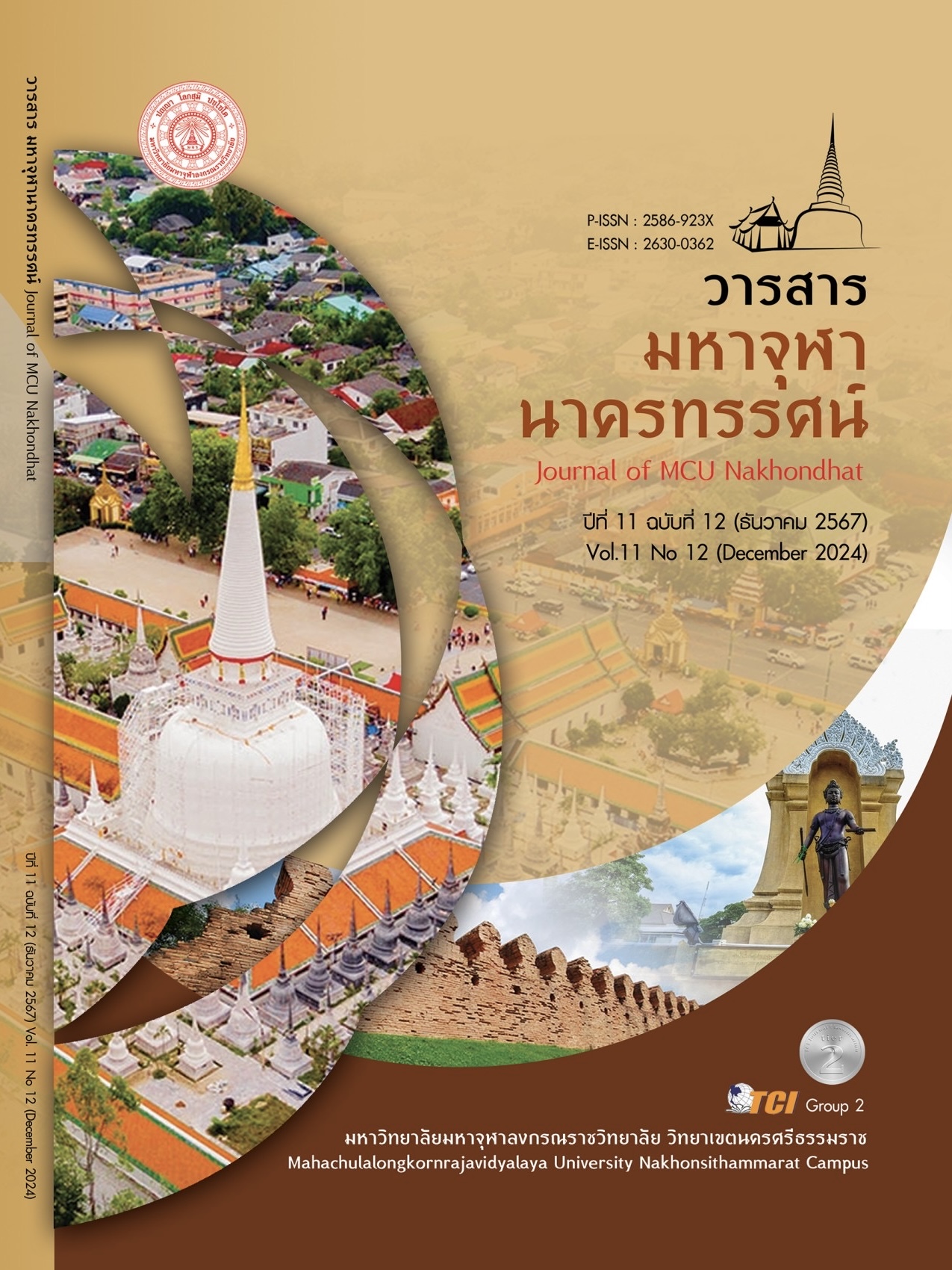A GUIDE TO CREATING PRODUCT PLACEMENT ADVERTISING ON YOUTUBE THAT EFFECTIVELY REACHES JAPANESE CONSUMERS
Main Article Content
Abstract
YouTube is an extremely popular online video website in Japan. Advertising on YouTube through product placement advertising by inserting content or placing products as part of a video is a successful method. This study aims to 1) Compare the differences in exposures, attitudes, and responses toward product placement on YouTube by demographic factors. 2) To study the relationship between exposure, attitude, and behavioral responses toward product placement on YouTube among Japanese consumers. This study used quantitative research collecting data from 200 Japanese samples. Using the T-test analyzed the data to compare all factors by demographic and using Pearson’s Correlation Coefficient to find the relationship between all variables. The result shows that the ages of 40 - 59 have more behavioral responses than those of 20 - 39. People in other marital statuses (e.g. married with children) have more intention to use and purchase than singles. The relationship between exposure, attitude, and behavioral responses towards product placement on YouTube was positively related at a moderate level of significance at 0.05. It can be explained that exposure to product placement on YouTube was most related to behavioral responses which the YouTube video that only included products as a prop resulted in the most exposure that could lead to behavioral responses. This research can be applied to marketing communications towards product placement on YouTube for Japanese consumers by smoothly placing advertisements as a prop and not pushing sales. Therefore, understanding the culture can be done by blending it into Japanese consumer behavior.
Article Details

This work is licensed under a Creative Commons Attribution-NonCommercial-NoDerivatives 4.0 International License.
References
กัลยา วานิชย์บัญชา. (2550). การวิเคราะห์สถิติ: สถิติสําหรับบริหารและวิจัย. กรุงเทพมหานคร: โรงพิมพ์จุฬาลงกรณ์มหาวิทยาลัย.
กิตติกันตพงศ์ สุเมธานุภาพ. (2565). ความเข้าใจพฤติกรรมเชิงลึกของผู้ชมรายการ The Golden Song เวทีเพลงเพราะของกลุ่ม เบบี้บูมเมอร์ และเจเนอเรชั่นเอ็กซ์ ในเขตกรุงเทพมหานครและปริมณฑล. วารสารวิชาการวิทยาลัยสันตพล, 8(1), 69-80.
ฉันธะ จันทะเสนา และคณะ. (2560). การศึกษาความพึงพอใจในคุณภาพการบริการทางอิเล็กทรอนิกส์. วารสารบริหารธุรกิจ มหาวิทยาลัยธรรมศาสตร์, 40(153), 45-63.
บุหงา ชัยสุวรรณ. (2558). การจัดกลุ่มและหาคุณลักษณะของกลุ่มดิจิทัลอิมมิแกรนท์ตามพฤติกรรมการสื่อสารในบริบทออนไลน์และปัญหาทางความสัมพันธ์กับสังคม. วารสารพัฒนบริหารศาสตร์, 58(1), 54-73.
ยุบล เบ็ญจรงค์กิจ. (2553). การตอบสนองของกลุ่มผู้บริโภคเป้าหมายต่อการประชาสัมพันธ์ทางสื่อใหม่: (Target Audience Responses to Public Relations through New Media). ใน รายงานการวิจัยกองทุนเพื่อการวิจัย. จุฬาลงกรณ์มหาวิทยาลัย.
วรวรรณ องค์ครุฑรักษา. (2564). อิทธิพลของการสื่อสารการตลาดในยูทูบที่มีต่อพฤติกรรมผู้บริโภคเจเนเรชั่น Z และ Y. วารสารการประชาสัมพันธ์และการโฆษณา, 14(1). 1-12.
วรวรรณ องค์ครุฑรักษา. (2566ก). การโฆษณาแฝงบนยูทูบไทยและญี่ปุ่น: จุดสมดุลของการขายสินค้า และการให้ข้อมูล การรับผิดชอบต่อสังคมและสิ่งแวดล้อม. วารสารมหาจุฬานาครทรรศน์, 10(12), 151-162.
วรวรรณ องค์ครุฑรักษา. (2566ข). การเปรียบเทียบทัศนคติต่อยูทูบเบอร์เสมือนจริงและพฤติกรรมตอบสนองต่อโฆษณาแฝงของผู้บริโภคชาวไทยและชาวญี่ปุ่น. วารสารการประชาสัมพันธ์และการโฆษณา, 16(2), 15-28.
วรวรรณ องค์ครุฑรักษา. (2566ค). การสำรวจการเปิดรับ ทัศนคติ และพฤติกรรมตอบสนองของผู้บริโภคต่อโฆษณาแฝงในยูทูบในช่วงการระบาดของโควิด 19. วารสารการสื่อสารและการจัดการ นิด้า, 9(1), 18-34.
วรวรรณ องค์ครุฑรักษา. (2567ข). อิทธิพลของอัตนิยมเชิงวัฒนธรรมและความเป็นสากลที่มีผลต่อพฤติกรรมตอบสนองต่อโฆษณาแฝงบนยูทูบของผู้บริโภคชาวญี่ปุ่น อิทธิพลของอัตนิยมเชิงวัฒนธรรมและความเป็นสากลที่มีผลต่อพฤติกรรมตอบสนองต่อโฆษณาแฝงบนยูทูบของผู้บริโภคชาวญี่ปุ่น. วารสารนิเทศศาสตรปริทัศน์, 28(2), 163-178.
Crespo, C. F. et al. (2023). The influence of storytelling on the consumer–brand relationship experience. Journal of Marketing Analytics, 11(1), 41-56.
JapanBuzz, T. (2024). Top 10 Popular YouTubers in Japan-Updated 2024. Retrieved January 17, 2024, from https://www.japanbuzz.info/youtubers-in-japan/
Kimura, Y. et al. (2023). Digital Media Consumption Trends in Family Households. Journal of Japanese Media Studies, 15(2), 45-60.
Kit, L. C. & Qui, E. L. (2014). The Effectiveness of Product Placement: The Influence of Product Placement towards Consumer Behavior of the Millennial Generation. International Journal of Social Science and Humanity, 4(2), 138-142.
LineShopping. (2022). เจาะลึกการตลาดแบบญี่ปุ่น ทำไมถึงครองใจคนซื้อทั่วโลก. Retrieved January 17, 2024, from https://lineshoppingseller.com/market-trend/japanese-marketing
Nextplora. (2023). The Evolution of Product Placement: Traditional Advertising vs. Native Integration. Retrieved January 17, 2024, from https://business.nextplora.com/the-evolution-of-product-placement-traditional-advertising-vs-native-integration/
Ongkrutraksa, W. (2022). Exploring Young Consumers’ Exposure, Attitude, and Behavioral Response to YouTube Video Game Streaming’s Product Placement. International Journal of Electronic Commerce Studies, 13(3), 45-68.
Principle. (2020). YouTube Trends in Japan and Everything Marketers Should Know. Retrieved January 17, 2024, from https://us.principle-c.com/blog/apac/youtube-trends-in-japan-and-everything-marketers-should-know/
Sproutsocial. (2022). YouTube Statistics to Power Your Marketing Strategy in 2022. Retrieved January 17, 2024, from https://sproutsocial.com/insights/youtube-stats/


